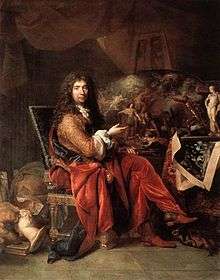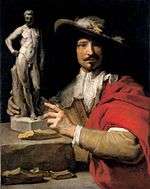Charles Le Brun
| Charles Le Brun | |
|---|---|
 Charles Le Brun, portrait by Nicolas de Largilliere | |
| Born |
February 24, 1619 Paris |
| Died |
February 22, 1690 (aged 70) Paris |
Charles Le Brun (24 February 1619 – 22 February 1690) was a French painter and art theorist. Declared by Louis XIV "the greatest French artist of all time", he was a dominant figure in 17th-century French art and much influenced by Nicolas Poussin.[1]
Biography



Early life and training
Born in Paris, he attracted the notice of Chancellor Séguier, who placed him at the age of eleven in the studio of Simon Vouet. He was also a pupil of François Perrier. At fifteen he received commissions from Cardinal Richelieu, in the execution of which he displayed an ability which obtained the generous commendations of Nicolas Poussin, in whose company Le Brun started for Rome in 1642.
In Rome he remained four years in the receipt of a pension due to the liberality of the chancellor. There he worked under Poussin, adapting the latter's theories of art.
On his return to Paris in 1646, Le Brun found numerous patrons, of whom Superintendent Fouquet was the most important, for whom he painted a large portrait of Anne of Austria.[2] Employed at Vaux-le-Vicomte, Le Brun ingratiated himself with Mazarin, then secretly pitting Colbert against Fouquet. Colbert also promptly recognized Le Brun's powers of organization, and attached him to his interests. Together they took control of the Academy of Painting and Sculpture (Académie royale de peinture et de sculpture, 1648), and the Academy of France at Rome (1666), and gave a new development to the industrial arts.
Another project Le Brun worked on was Hôtel Lambert. The ceiling in the gallery of Hercules was painted by him. Le Brun started work on the project in 1650, shortly after his return from Italy. The decoration continued intermittently over twelve years or so, as it was interrupted by the renovation of Vaux le Vicomte.
In 1660 they established the Gobelins, which at first was a great school for the manufacture, not of tapestries only, but of every class of furniture required in the royal palaces. Commanding the industrial arts through the Gobelins—of which he was director—and the whole artistic world through the Academy—in which he successively held every post—Le Brun imprinted his own character on all that was produced in France during his lifetime. He was the originator of Louis XIV Style and gave a direction to the national tendencies which endured centuries after his death.
Success years
The nature of his emphatic and pompous talent was in harmony with the taste of the king, who, full of admiration of the paintings by Le Brun for his triumphal entry into Paris (1660) and his decorations at the Château Vaux le Vicomte (1661), commissioned him to execute a series of subjects from the history of Alexander. The first of these, "Alexander and the Family of Darius," so delighted Louis XIV that he at once ennobled Le Brun (December, 1662), who was also created Premier Peintre du Roi (First Painter of the King) with a pension of 12,000 livres, the same amount as he had yearly received in the service of the magnificent Fouquet. The King had declared him "the greatest French artist of all time".
From this date all that was done in the royal palaces was directed by Le Brun. In 1663,[3] he became director of the Académie royale de peinture et de sculpture, where he laid the basis of academicism and became the all-powerful, peerless master of 17th-century French art. It was during this period that he dedicated a series of works to the history of Alexander The Great (The Battles of Alexander The Great), and he did not miss the opportunity to make a stronger connection between the magnificence of Alexander and that of the great King. While he was working on The Battles, Le Brun's style became much more personal as he moved away from the ancient masters that influenced him.
The works of the gallery of Apollo in the Louvre were interrupted in 1677 when he accompanied the king to Flanders (on his return from Lille he painted several compositions in the Château de Saint-Germain-en-Laye), and finally—for they remained unfinished at his death—by the vast labours of Versailles, where he reserved for himself the Halls of War and Peace (Salons de la Guerreand de la Paix, 1686), the Ambassadors' Staircase, and the Great Hall of Mirrors (Galerie des Glaces, 1679–1684). Le Brun's decoration is not only a work of art, it is the definitive monument of a reign.
Later years
At the death of Colbert, François-Michel le Tellier, Marquis de Louvois, Colbert's enemy, who succeeded as superintendent in the department of public works, showed no favour to Le Brun who was Colbert's favorite, and in spite of the king's continued support Le Brun felt a bitter change in his position. This contributed to the illness which on 22 February 1690 ended in his death in his private mansion, in Paris.
Le Brun's work and legacy
Le Brun primarily worked for King Louis XIV, for whom he executed large altarpieces and battle pieces. His most important paintings are at Versailles. Besides his gigantic labours at Versailles and the Louvre, the number of his works for religious corporations and private patrons is enormous. Le Brun was also a fine portraitist and an excellent draughtsman, but he was not fond of portrait or landscape painting, which he felt to be a mere exercise in developing technical prowess. What mattered was scholarly composition, whose ultimate goal was to nourish the spirit. The fundamental basis on which the director of the Academy-based his art was unquestionably to make his paintings speak, through a series of symbols, costumes and gestures that allowed him to select for his composition the narrative elements that gave his works a particular depth. For Le Brun, a painting represented a story one could read. Nearly all his compositions have been reproduced by celebrated engravers.
In his posthumously published treatise, Méthode pour apprendre à dessiner les passions (1698) he promoted the expression of the emotions in painting. It had much influence on art theory for the next two centuries.
Many of his drawings are in the Louvre and the Monaco Royal Collection. He was also the teacher of painter Ludovico Dorigny.

On 23 January 2013, artistic advisors for the Hôtel Ritz Paris, Wanda Tymowska and Joseph Friedman, announced the discovery of The Sacrifice of Polyxena, an early work of Le Brun. The picture, dated 1647, ornamented the Coco Chanel suite of the famous Parisian palace, and went unnoticed for over a century.[4][5]

Partial anthology of works
- Décorations
- Decoration of the ceiling of the Galerie d'Apollon, at the Louvre Palace.
- Decoration of the château de Vaux-le-Vicomte : King's room, Le Temps enlevant au Ciel la Vérité.
- Cupola of the Pavillon de l'Aurore at the château de Sceaux.
- Murals of the ceiling of the Galerie des Glaces, Palace of Versailles.
- Apotheosis of Romulus, cycle eight paintings for the ceiling of a room in the Hôtel d'Aumont, Paris.
- Canvases
- The Sleep of Jesus, musée du Louvre.
- Chancellor Séguier and his suite musée du Louvre.
- Paintings of the Story of Alexander, musée du Louvre.
- Louis XIV presenting his sceptre and his helmet to Jesus-Christ, musée des beaux-arts de Lyon.
- Cycle of four paintings : Air, Earth, Fire and Water, Musée des Beaux-Arts et d'Archéologie de Châlons-en-Champagne.
- Publications
- Méthode pour apprendre à dessiner les passions (1698), posthumous publication.
Gallery
-

Louis XIV Equestrian Portrait, oil on canvas, Musée des Beaux-Arts, Tournai.
-
Entry of Alexander into Babylon, ca. 1664, oil on canvas, Louvre.
-

Portrait of Louis XIV, 1661.
-

The Queens of Persia at the feet of Alexander, also called The Tent of Darius.
-

Portrait of the painter Louis Testelin, ca. 1650, oil on canvas, Louvre.
-

Daedalus and Icarus, c. 1645
-

The Descent from the Cross, late 1640s
-

The fall of the rebel angels, after 1680, oil on canvas, Musée des Beaux-Arts, Dijon.
-

Louis XIV Equestrian Portrait, 1668, oil on canvas, Musée de la Chartreuse, Douai.
-

Apotheosis of Louis XIV, 1677, oil on canvas, Magyar Szépmüvészeti Múzeum, Budapest.

References and sources
References
- ↑ Honour, H. and J. Fleming, (2009) A World History of Art. 7th edn. London: Laurence King Publishing, p. 604. ISBN 9781856695848
- ↑
 "Charles Lebrun". Catholic Encyclopedia. New York: Robert Appleton Company. 1913.
"Charles Lebrun". Catholic Encyclopedia. New York: Robert Appleton Company. 1913. - ↑ Walsh, L. (1999) "Charles le Brun, ‘art dictator of France’", in Perry, G. and Cunningham, C. (eds.) Academies, museums and canons of art. New Haven: Yale University Press, p. 86. ISBN 0300077432
- ↑ AMA, 25 January 2013
- ↑ Ansamed.info, 23 January 2013
Sources
| Wikimedia Commons has media related to Charles Le Brun. |
- Michel Gareau, Charles LeBrun First Painter To King Louis XIV, Abrams NY, 1992
- Morel d'Arleux, Louis-Marie-Joseph, Dissertation sur un traité de Charles Le Brun concernant le rapport de la physionomie humaine avec celle des animaux (1827)
- Pinault-Sorensen, Madeleine, De la Physionomie Humaine et Animale: Dessins de Charles Le Brun gravés pour la Chalcographie du Musée Napoleon en 1806, Musée du Louvre, (2000) (ISBN 2-7118-4094-8)
- www.CharlesLeBrun.com (website)
Attribution
 This article incorporates text from a publication now in the public domain: Anonymous (1911). "Le Brun, Charles". In Chisholm, Hugh. Encyclopædia Britannica (11th ed.). Cambridge University Press.
This article incorporates text from a publication now in the public domain: Anonymous (1911). "Le Brun, Charles". In Chisholm, Hugh. Encyclopædia Britannica (11th ed.). Cambridge University Press.
|
